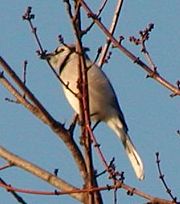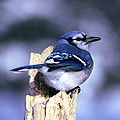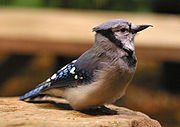
Blue Jay
Did you know...
This Wikipedia selection is available offline from SOS Children for distribution in the developing world. Click here for more information on SOS Children.
| Blue Jay | |
|---|---|
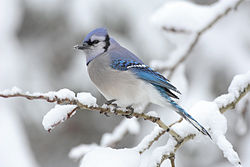 |
|
| In Algonquin Provincial Park (Canada), the large subspecies Cyanocitta cristata bromia occurs. | |
| Conservation status | |
|
Least Concern ( IUCN 3.1) |
|
| Scientific classification | |
| Kingdom: | Animalia |
| Phylum: | Chordata |
| Class: | Aves |
| Subclass: | Neornithes |
| Infraclass: | Neognathae |
| Superorder: | Neoaves |
| Order: | Passeriformes |
| Suborder: | Passeri |
| Superfamily: | Corvoidea |
| Family: | Corvidae |
| Genus: | Cyanocitta |
| Species: | C. cristata |
| Binomial name | |
| Cyanocitta cristata Linnaeus, 1758 |
|
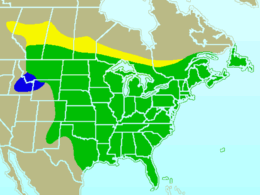 |
|
| Global range. Yellow: breeding only Green: Resident all year Blue: wintering only. See also text for recent range expansion. |
|
The Blue Jay (Cyanocitta cristata) is a passerine bird, a member of the family Corvidae native to North America. It belongs to the "blue" or American jays, which are, among the Corvidae, not closely related to other jays. It is adaptable, aggressive and omnivorous, and has been colonizing new habitat for many decades.
Description
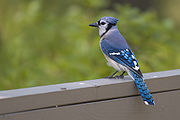
The Blue Jay measures 9-12 inches (22-30 cm) from bill to tail and weighs 2.47-3.53 ounces (70–100 g), with a wingspan of 13–17 in (34–43 cm). There is a pronounced crest on the head, a crown of feathers, which may be raised or lowered according to the bird's mood. When excited or aggressive, the crest may be fully raised. When frightened, the crest bristles outwards, brushlike. When the bird is feeding among other jays or resting, the crest is flattened to the head.
Its plumage is lavender-blue to mid-blue in the crest, back, wings, and tail, and its face is white. The underside is off-white and the neck is collared with black which extends to the sides of the head. The wing primaries and tail are strongly barred with black, sky-blue and white. The bill, legs, and eyes are all black. Males and females are nearly identical; males are slightly larger.
As with other blue-hued birds, the Blue Jay's coloration is not derived by pigments, but is the result of light refraction due to the internal structure of the feathers; if a blue feather is crushed, the blue disappears as the structure is destroyed. This is referred to as structural coloration.
Vocalizations
Blue Jays can make a large variety of sounds, and individuals may vary perceptibly in their calling style. Like other corvids, they may learn to mimic human speech. Their voice is typical of most jays in being varied, but the most commonly recognized sound is the alarm call, which is a loud, almost gull-like scream. There is also a high-pitched jayer-jayer call that increases in speed as the bird becomes more agitated. Blue Jays will use these calls to band together to mob potential predator such as hawks and drive them away from the jays' nests.
Blue Jays also have quiet, almost subliminal calls which they use among themselves in proximity. One of the most distinctive calls of this type is often referred to as the "rusty pump" owing to its squeaky resemblance to the sound of an old hand-operated water pump. The Blue Jay (and other corvids) are distinct from all other songbirds for using their call as a birdsong.
The blue jay (Cyanocitta cristata) is from the Passeriformes which means perching birds. Most of the birds in this order are small in size, but they have a larger learning ability than most birds. Passerine birds are divided into two sub orders: the suboscines and the oscines. The Oscines are capable of complex song and are considered true song birds. The blue jay lives in yards, gardens, woods, and parks; and prefers Oak trees or beech trees. Also all Blue Jays have strong black bills used for cracking nuts, and acorns and for Eating corn, grains and seeds. They also eat insect such as beetles, grasshoppers, and caterpillars. Blue Jays have three toed feet which are good for wrapping around tree branches.
Range
The Blue Jay occurs from southern Canada through the eastern and central USA south to Florida and northeastern Texas. The western edge of the range stops where the arid pine forest and scrub habitat of the closely related Steller's Jay (C. stelleri) begins. Recently, the range of the Blue Jay has extended northwestwards so that it is now a rare but regularly-seen winter visitor along the northern US and southern Canadian Pacific Coast, and some stray birds may even occur in California nowadays. As the two species' ranges now overlap, it sometimes hybridize with Steller's Jay.
Namely the northernmost subspecies C. c. bromia is migratory, subject to necessity. It may withdraw several hundred kilometers south in the northernmost parts of its range, but even northern birds do not necessarily move south, particularly in mild years with plentiful winter food. It migrates during the daytime, in loose flocks of 5 to 250 birds.
Subspecies
Four subspecies are generally accepted, though the variation within this species is rather subtle and essentially clinal. No firm boundaries can be drawn between the inland subspecies. The ranges of the coastal races are better delimited.
- Cyanocitta cristata bromia – Northern Blue Jay
- Cyanocitta cristata cristata – Coastal Blue Jay
- Coastal USA from North Carolina to Texas, except southern Florida. Mid-sized and very intensely blue.
- Cyanocitta cristata cyanotephra – Interior Blue Jay
- Inland USA, intergrading with C. c. bromia to the north. Mid-sized, quite dark blue on mantle contrasting cleanly with very white underside.
- Cyanocitta cristata semplei – Florida Blue Jay
- Southern Florida. The smallest subspecies, much like C. c. bromia in colour.
-
C. c. bromia standing alert, Ontario (Canada).
Ecology
The Blue Jay occupies a variety of habitats within its large range, from the pine woods of Florida to the spruce- fir forests of northern Ontario. It is less abundant in denser forests, preferring mixed woodlands with oaks and beeches. It has expertly adapted to human activity, occurring in parks and residential areas, and can adapt to wholesale deforestation with relative ease if human activity creates other means for the jays to get by.
The Blue Jay is a slow flier and an easy prey for hawks and owls, when it flies in open lands. It flies with body and tail held level, with slow wing beats. It is generally assertive toward other birds, and it may chase birds from feeders or other food sources. It may chase predatory birds, such as hawks and owls which occasionally feed on jays, and will scream if it sees a predator within its territory. It has also been known to sound an alarm call when hawks or other dangers are near, and smaller birds often recognize this call and hide themselves away accordingly. It may also be aggressive towards humans who come close to its nest, and if an owl roosts near the nest during the daytime the Blue Jay mobs it until it takes a new roost.
Blue Jays, like other corvids, are highly curious and very intelligent birds. Young individuals playfully snatch brightly coloured or reflective objects, such as bottle caps or pieces of aluminium foil, and carry them around until they lose interest. Blue Jays in captivity have been observed using strips of newspaper as tools to obtain food.
Diet

Its food is sought both on the ground and in trees and includes virtually all known types of plant and animal sources, such as acorns and beech mast, weed seeds, grain, fruits and other berries, peanuts, bread, meat, eggs and nestlings, small invertebrates of many types, scraps in town parks and bird-table food. Blue Jays will sometimes cache food, though to what extent differs widely among individuals.
The Blue Jay has a bad reputation as a raider of other bird's nests, stealing eggs, chicks, and nests. However, this may not be as widespread as is typically thought. A scientific study found only 1% of Blue Jays had evidence of nestlings or eggs in their stomachs.
Reproduction
The breeding season begins in mid-March, peaks in mid-April to May, and extends into July. Any suitable tree or large bush may be used for nesting, though an evergreen is preferred. The nest is preferentially built at a height of 3 to 10 m. It is cup-shaped and composed of twigs, small roots, bark strips, moss, other plant material, cloth, paper, and feathers, with occasional mud added to the cup.
Blue Jays are not really picky about nesting locations. If no better place is available - e.g. in a heavily deforested area - they will even use places like the large letter boxes typical of the rural United States. They also appropriate nests of other mid-sized songbirds as long as these are placed in suitable spots; American Robin nests are commonly used by Blue Jays for example.
Blue Jays typically form monogamous pair bonds for life. Both sexes build the nest and rear the young, though only the female broods them. The male feeds the female while she is brooding the eggs. There are usually 4–5 eggs laid and incubated over 16-18 days. The young fledge usually between 17-21 days after hatching.
After the juveniles fledge, the family travels and forages together until early fall, when the young birds disperse to avoid competition for food during the winter.
